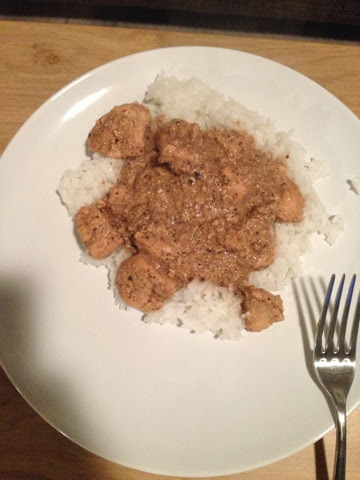Here's another chicken curry for ya'll (no, I'm not from the South) to try! This was a last minute sort-a curry, but I can't really remember how I landed on it (there's so many to choose from!) ... my thought process probably went something like this
Chicken doesn't need to be marinated? ... check.
Do I have all the ingredients listed? ... check.
Simple process?... check.
Done!
As you can see in the first photo, this is a vindaloo... which equals spicy, but in my opinion the coconut milk significantly cuts down the heat. You can still make this recipe and tailor it for your tolerance level, but if you're not into spicy food, I'd recommend trying another chicken curries with more flavor (check out some of my past posts!).
So, here's the recipe:
Chicken Simmered in a Coconut Milk-Vinegar Sauce
Ingredients:
As I have now cooked a significant number of curries from this cook book, I prefer a higher ratio of curry (sauce) to chicken. I have tailored my recipe accordingly.
- 2 tablespoons of oil (I used coconut oil, recipe calls for canola)
- 1 medium sized red onion, cut in half lengthwise and thinly sliced
- 300 grams of chicken breast cut up into approximately 1 inch cubes
- 1/4 cup distilled white vinegar (I didn't have enough vinegar so I used up what I had and filled the remainder with cider vinegar per the suggestion in the book)
- a couple cloves of garlic minced
- 1 tablespoon of coriander seeds, ground (freshly ground is best)
- 2 teaspoons of cumin seeds, ground (freshly ground is best)
- 1 teaspoon cayenne pepper
- 1/4 teaspoon cayenne pepper mixed with 3/4 teaspoon of sweet paprika (the recipe calls for 1 teaspoon of ground Kashmiri chiles, but since I don't have this I used the replacement)
- 1 teaspoon of sea salt
- 1/4 teaspoon ground turmeric
- 1 cup unsweetened coconut milk
Directions:
- Heat the oil in a large skillet over medium-high heat. Once warm, add the onion and cook until light brown until light brown around the edges (stir so they don't burn), about 3-5 minutes.
- Lower the heat to medium and add the chicken pieces. Cook until they have browned, about 2-3 minutes per side. Transfer the chick and onion to a plate.
- Pour the vinegar into the skillet and add the minced garlic, ground coriander, ground cumin, cayenne, Kashmiri chiles (or replacement), salt and turmeric. Scrape the bottom of the skillet to deglaze. Reduce the heat to medium-low, cover, and simmer the sauce, stirring occasionally until some of the oil starts to separate around the edges of the skillet and on the surface.
- Stir in the coconut milk, and return the chicken to the skillet. Cook, covered stirring occasionally, until the meat in the thickest parts of the chicken is no longer pink inside and the juices run clear, about 18 to 20 minutes. Cook longer if desired to thicken the sauce (note the original recipe calls to remove the chicken and then thicken the curry separately... I chose not to do this for the sake of time and convenience!).
- Raghavan mentions that cider or malt vinegar can be used instead of white wine vinegar for a sweeter tasting sauce. As I mentioned above, I used cider vinegar out of necessity. I didn't detect much sweetness, so it's subtle at most.
Note, I served with rice, as is pretty much always standard for me. You could certainly serve with naan or roti, but I find the rice soaks up the curry best, also cutting a bit of the heat.
Hope you enjoy this curry!





























